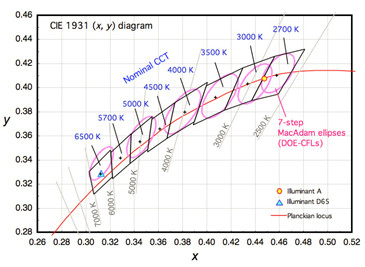Exploring Light Source color accuracy through the Lens of CRI, SDCM, R9
Author:Admin Publish time: August 14, 2023 Origin: Site
In the realm of modern lighting technology, the pursuit of excellence goes beyond the mere illumination of spaces. The consistent quality of light sources has become a paramount consideration in creating optimal visual experiences. This article embarks on a journey to unveil the intricate relationship between light source consistency and critical metrics: Color Rendering Index (CRI), Standard Deviation of Color Matching (SDCM), R9 value”
1 .CRI (Color Rendering Index)
CRI is a quantitative measure of a light source's ability to reproduce the colors of objects faithfully in comparison to an ideal or natural light source. It's a scale from 0 to 100, with 100 indicating that the light source renders colors identically to natural sunlight.

Components of CRI:
R1-R8: These are the standard set of colors used to calculate the average CRI. They consist of pastel colors including skin tones and natural colors like leaf green.
R9-R15: These are the extended set of colors, with R9 being the most discussed due to its importance in rendering red hues.
Why is CRI Important?
Visual Comfort: High CRI values ensure that the colors in the environment appear as they would under natural light, providing visual comfort and aesthetic appeal.
Task Efficiency: Accurate color rendering is crucial in tasks like cooking, reading, and artwork, where color differentiation is essential.
In the lighting industry, the basic requirement for CRI (Color Rendering Index) in LED bulbs can vary depending on the application and the desired level of color accuracy. However, a common standard is to have a minimum CRI of 80 or higher for LED bulbs, now newest ERP directive has a minimum request is Ra>80, and most LED Bulb supplier and customer take it as basic requirement, While in California JA8 Title 20/24 test standard have Ra basic requirement is >90, which is vary by different certificates standards.
Ideal Value: A CRI of 90 and above is considered excellent and is often recommended for spaces where color accuracy is crucial, such as art studios, retail spaces, and medical facilities.
General Use: For general residential and office spaces, a CRI of 80 and above is typically sufficient.
Note: While a CRI of 100 represents the quality of natural sunlight, it's rare for artificial light sources to achieve this perfect score. However, values close to 100 are indicative of top-tier color rendering.
2. SDCM (Standard Deviation of Color Matching)

SDCM is a metric used to describe the consistency of color output from one LED to another. It's a measure of color variation and is expressed in MacAdam Ellipses. A smaller SDCM value indicates that the color variation between LEDs is minimal and less noticeable to the human eye.
Why is SDCM Important?
Uniformity: In architectural and design applications, consistent lighting is crucial. Variations in color can disrupt the visual harmony of a space.
Quality Control: SDCM values are often used by manufacturers as a quality control metric, ensuring that batches of LEDs produce consistent color output.
Conclusion
Ideal Value: An SDCM of 2 or less is excellent, indicating minimal color variation between individual LEDs. Such a low SDCM ensures uniformity and consistency in lighting applications.
General Use: An SDCM of 3/4 is generally acceptable for most applications. However, for architectural and design-focused projects, striving for an SDCM of 2 or less is recommended.
Note: SDCM values are often represented in terms of MacAdam Ellipses. A 1-step MacAdam Ellipse is roughly equivalent to an SDCM of 1, indicating high consistency.
Different industries, such as architectural lighting, display manufacturing, and automotive lighting, might have their own guidelines for acceptable SDCM levels based on the visual impact of color variation in their respective applications. For Newest ERP 2021 directives it requires the SDCM <6.
3.R9: The Red Color Rendering Index
R9 is one of the extended Color Rendering Index (CRI) values that specifically measures how accurately a light source renders the color red. Red is a challenging color for many light sources to reproduce accurately, especially for LED lighting.
Why is R9 Important?
Vibrancy: Red objects, from fruits to fabrics, appear more vibrant and true-to-life under a light source with a high R9 value.
Skin Tones: Red plays a significant role in rendering skin tones accurately. A light source with a low R9 might make skin appear dull or unhealthy.
Challenges with R9 in LED Lighting:
LEDs often struggle with rendering reds because of their blue light spectrum, which lacks the broader spectrum required to reproduce red hues accurately. However, advancements in phosphor technology and spectral tuning are bridging this gap.
Ideal Value: An R9 value of 90 or above is outstanding, ensuring that red hues are rendered vibrantly and accurately. This is especially important in spaces where the accurate portrayal of red is crucial, such as photography studios or fashion retail spaces.
General Use: An R9 value of 50 and above is acceptable for most residential applications. However, for spaces where skin tones and aesthetics are a priority, aiming for higher R9 values is beneficial.
Note: Many LED products on the market may have high CRI values but low R9 values. It's essential to check both metrics to ensure overall color accuracy.

CRI measures how accurately a light source renders colors compared to a reference light source, typically daylight. It tells us how well colors appear under a specific light. A higher CRI indicates better color accuracy.
SDCM, on the other hand, quantifies the variation in color appearance among multiple light sources of the same kind. It defines the acceptable range of color difference that is imperceptible to the human eye.
The relationship between CRI and SDCM lies in their combined impact on the overall quality of light. While CRI focuses on individual color accuracy, SDCM focuses on the consistency of color across different light sources. A light source with a high CRI but a wide SDCM value might have accurate individual colors but noticeable variations between different instances of that light source. Conversely, a light source with a high CRI and a low SDCM value would offer both accurate colors and consistent color appearance across different instances.
The interplay of R9, CRI, and SDCM is crucial in determining the quality and consistency of lighting. While R9 focuses on the accurate rendering of red hues, CRI provides a broader perspective on color accuracy. SDCM, on the other hand, ensures that the lighting remains consistent across multiple sources. As consumers and professionals, understanding these metrics can guide us in making informed decisions, ensuring that our spaces are not only well-lit but also visually comforting and true to life.
In the dynamic world of LED lighting, consistency is not just a metric – it's a promise. At Saco lighting limited, we've always prioritized consistency, ensuring that every light source we produce meets the highest standards of quality and performance. We understand the challenges our clients face in achieving uniform lighting, and we're dedicated to providing solutions that stand out, basic standard is CRI>90,SDCM<3/4,,R9>90,which will be 100% quality control for great color uniformity and accuracy .
